#1492 Pictures
Explore tagged Tumblr posts
Text
youtube
My second Jedtavius MV
#MV#Music video#Octavius#Jedediah#Jedtavius#You Know I Will#The Fox and the Hound 2#Lucas Grabeel#Night at the Museum#Night at the Museum: Battle of the Smithsonian#Night at the Museum: Secret of the Tomb#Fanart#Fanart drawn by me#Tumblr#Tumblr fanart#DeviantArt#Deviantart art#Twentieth Century Fox#1492 Pictures#Twenty-One Laps Production#Owen Wilson#Steve Coogan#Disney#YouTube#Second#Pinterest#Pinterest art#Fanpop#Fanpop art#Other art
8 notes
·
View notes
Text

Happy 4th Anniversary To Scoob!
3 notes
·
View notes
Text
02.06.24
#Mira-Marathon | Night at the Museum
Film Name: Night at the Museum (2006); Production Studios: Twentieth Century Fox, 21 Laps Entertainment, Ingenious Media, Dune Entertainment, 1492 Pictures, Sun Canada Productions; Director by: Shawn Levy; Screenwriters: Robert Ben Garant, Thomas Lennon; Starring: Ben Stiller, Jake Cherry, Carla Gugino, Robin Williams, Steve Coogan; Genres: Fantasy, Adventure, Comedy, Family; Running Time: 1 hour 48 minutes;
"Night at the Museum" (2006) is a comedy with Ben Stiller, where museum exhibits come alive at night. The film is distinguished by light humor, good acting and visual effects. Although the plot is predictable and the secondary characters are weakly developed, the film is ideal for family viewing.
My rating:
⭐⭐⭐

#mira marathon#night at the museum#natm#film#2006#twentieth century fox#21 laps entertainment#ingenious media#dune entertainment#1492 pictures#sun canada productions#shawn levy#robert ben garant#thomas lennon#ben stiller#jake cherry#carla gugino#robin williams#steve coogan#fantasy#adventure#comedy#family#1 hour#⭐⭐⭐
2 notes
·
View notes
Note
hi, i hope you dont mind me asking this question! i often come across lists of reading recommendations for communists, and they are usually focused entirely on communist theory. which is important and im already on that, but i wonder if you also have recs for learning about history? especially the history of the soviet union, but also other past and present socialist states. i sometimes find myself reading theory and understanding the concepts in a vacuum, but with very little understanding of the historical context they were written in, if that makes any sense. and id like to get a basic grasp of the history of various socialist projects that isnt just the typical western "the ussr was evil!!!!" thing
Hi, historical context is indeed very important for works of theory, especially if it's more than a hundred years old. Lenin's What is to be Done, for example, is very conditioned by its historical context of Russia still being predominantly feudal, with only a timid appearance of the proletariat in St. Petersburg and Moscow, and therefore the very first trade unions, which he talks about. The understanding of these texts is amplified, and quite often enabled by knowing at least the basic historical context. Below I'll list the historical works I've read (and others) with some commentary, but I encourage anyone who has something to add to do so, since I am as of only recently getting more into historiography.
Anything by Anna Louise Strong (I've read The Soviets Expected it (1941) and In North Korea (1941), there's also The New Lithuania (1941), The Stalin Era (1956) and When Serfs Stood Up in Tibet (1959) for example). Her works, which I'd consider primary sources since they are written from her own experience witnessing events and talking to a lot of people, are extremely useful if you wish to form an idea about how some aspects of socialist states worked. The limitation of her works also resides in this specificity and closeness, these are not works that present a broad view of long processes, but a slice of the present with the sufficient historical context. They are still very, very good.
The Open Veins of Latin America (Spanish versrion), by Eduardo Galeno (1971). This one is focused on the history of imperialism in Latin America, how it evolved from the moment the first Spanish foot touched ground to the time it was written in (It talks about Allende before he was assassinated but after achieving power, for example). Perhaps it's not exactly what you're looking for, but it contains very important general context for any social movement that has happened since 1492 to 1971
The Triumph of Evil, by Austin Murphy (2002). I have mixed feelings about this book. While it insists on this weird narrative of absolute evil, which IMO takes away a lot of value from the overall points made, it is an astonishingly in-depth analysis of the economic performance and general merit of socialist systems against their capitalist counterparts. Most of the book is dedicated to comparing the GDR to the FRG, and both the economic and social data it exposes was very eye-opening to me when I read it about 2 years ago. If you can wade through the moralism (especially the beginning of the introduction), it's a gem. I've posted pictures of its very detailed index under the cut :)
Blackshirts and Reds, Michael Parenti (1997). Despite the very real criticisms levied against this book, like its mischaracterization of China, it is still a landmark work. Synthetically, it exposes the relationship between fascism, capitalism and communism.
Red Star Over the Third World, Vijay Prashad (2019); The Russian Revolution: A View from the Third World, Walter Rodney (2018). I'm lumping these two together (full disclosure, as of writing I'm about four fifths of the way through RSOtTW) because they deal with the same topic, Prashad being influenced by Rodney as well. Like both titles imply, they deal with the effects the October revolution had on the exploited peoples of the world, which is a perspective that's often lost. Through this, they (at least Prashad) also talk about the early USSR and how it functioned. For example, up until reading Red Star, I hadn't even heard of the 1920 Congress of The Toilers of the East in Baku, or the Congress of the Women of the East.
From here on I'll link works that I haven't (yet) read, but I have seen enough trusted people talk about them to include them
How to Cast a God into Hell: The Khrushchev Report, by Domenico Losurdo (2008). This one talks about how the period of Stalin was twisted and exaggerated through destalinization.
Devils in Amber, by Philips Bonoski (1992). This is about the Baltics and their historical trajectory from before WW1 to the destruction of the USSR (I'm not very sure on those two limits, perhaps they fluctuate a bit, but it definitely covers from WW1 to the 60s)
Socialism Betrayed, by Roger Keeran and Thomas Kenny (2004). This one deals with the process leading up to and the destruction of the USSR itself.
The Jakarta Method, Vincent Bevins (2020). This is about the methods the US used in the second half of the 20th century to stamp out, prevent, or otherwise sabotage communist movements and other democratic anti-imperialist movements.
I know some of these aren't specifically about socialist states, which is what you asked, but the history of its opposition is just as important to understand because it always exists as a condition to these countries' development and policies chosen.



406 notes
·
View notes
Note
I’m interested in your theory of what Gortash was a counsellor of? Or what department of high ranking official of the city he was working for?
Oooh thank you for the opportunity to talk about Baldurian politics 🙏 (somehow this developed footnotes) (and got really long, whoops)
I don't think I'm settled on who initially hired him—it could be one of the five officers of the city* who typically hire bureaucrats, or a duke (since it seems Florrick works primarily with Ravengard and the Fist).
I think most likely would be Earl Namorran (the Harbormaster circa 1482) or Thalamra Vanthampur** (either while she was Master of Drains and Underways or after becoming a duke), though I do picture some leeway in who the counsellors advise once they're in place, more about where their advice is needed than necessarily being tied to a particular area.
(I was trying to source back where I got that impression, and I think it's Wyll describing Gortash as trying to be an advisor to "the peers" in general:)

(He's thinking back to 1485 and before, when he still lived in the Gate—the "bit player" part became less true the closer you get to 1492, I imagine, especially with the narrator line that attributes the title counsellor to Gortash describing him as having considerable influence on industry and politics)
Some areas I could see Gortash being a fit to advise on would be a) weaponry (but we know the Watch marshal is skeptical of his ideas in 1492, and Ulder Ravengard certainly doesn't like his advice, so I can't picture him spending much time advising the Watch or the Fist despite any overtures), b) the flow of goods in and out of the city, and c) technology.
(Technology is why I'm imagining Vanthampur as a possible entrypoint: the drains and underways porfolio is prestigious because it's so technically demanding in a way that's beyond most patriars.)
And speaking of technology, personally I see him working a lot with the Gondians and the ways they interface with the city!
After Duke Torlin Silvershield's death, the high artificer of Gond becomes Andar Beech, who oversaw the temple's day-to-day under Silvershield and was critical of his involvement in politics—so I think that leaves an opening for someone outside of Gond's church to step in and do some of that liaising. Because the city really, really cares about the Gondians—they maintain those giant cranes that move all the goods at the docks and keep trade flowing, relevant to Namorran's work, and they repair plumbing in patriars' homes, relevant to Vanthampur's—and I could see him advising parliament and the dukes on how they might best get more use out of the Gondians and their inventions. (While at the same time using them as jumping-off points for his own.)
We know the Gondians likely had a lot of secret projects going on (I don't have a link, but the rumour's from Descent into Avernus!), and Gortash eventually takes their Foundry through fraud and blackmail, so I can picture him using his role as counsellor to twist his way in to learn more for leverage and to start to legitimize a partnership between him and the Gondians in the public's eye: setting himself up to take direct, forceful control like we see him having in 1492.
-----
*those five officer positions being: Harbormaster, High Constable and Master of Walls, Master of Drains and Underways, Master of Cobbles, and the Purse Master, per Murder in Baldur's Gate
**Follower-of-Zariel and owner-of-a-bathhouse-that-by-1492-has-a-bane-bhaal-and-mrykul-temple-under-it Thalamra Vanthampur!
73 notes
·
View notes
Text
Shadow Curse Events Pt. 1
Ketheric, Selûne, Shar, and Aylin

I’ve played through the game a few times at this point and I always find myself struggling to understand the timeline or at least order of events that occurred with the Shadow Curse. I know some things conflict because there was one version of the story in Early Access (the version where Halsin accidentally killed Isobel) and it was heavily altered for the final version of the game, and some things just got *gestures vaguely* waved away, but I keep wanting to make sense of it anyway.
So that’s what this post (edit: I mean series) is going to do. After the cut, obviously. Long deep dive post ahead! Picture of a tired Ketheric for attention and because same bro c':
TLDR: These events happen either in the 1370s or the 1390s. Ketheric loses Melodia (his wife) and Isobel (his daughter) and turns to Shar. He captures Aylin, then builds a Big Dark Justiciar Army, training them and forcing them to kill Aylin over and over. Meanwhile, a Selûnite resistance is brewing in the town, and it's kind of making everything worse. One Selûnite rebel even goes so far as to make a deal with a devil. And all of that is BEFORE the Harpers and druids arrive as an army.
We don’t have dates, unfortunately, aside from knowing that the shadow curse itself was unleashed about a century ago, so “timeline” would be a loose term to use if/when I use it. But I have two theories about when it happened.
One theory is that because the Spellplague was happening between 1385-1395 DR (during which there was neither a true Weave nor a Shadow Weave, which is what the shadow curse is made of), the shadow curse likely started around 1396-1399, just shy of a full 100 years before the game’s events in 1492. But that’s just me conjecturing based on the idea that if the Shadow Weave is gone…how does the shadow curse stick around?
The other theory is that the shadow curse was unleashed sometime between 1371 and 1374. This is because a) Dark Justiciars were still being sent by Ketheric Thorm to destroy Moonhaven (the Blighted Village) in 1371 (Ketheric writes a letter about attacking Moonhave and a journal dated 1371 boasts that Ilyn Toth, the basement apothecary-necromancer dude, got killed by Dark Justiciars) and b) because Khelben Arunsun himself, the literal Blackstaff (super powerful and very old wizard), wrote a letter negotiating surrender on behalf of the Harpers.
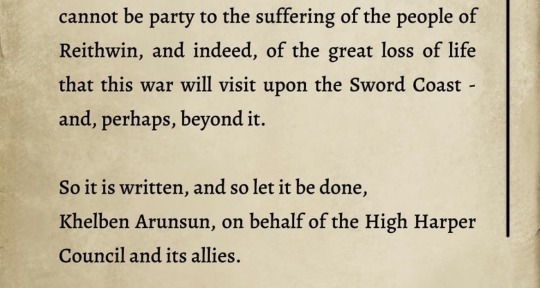
We cannot be party to the suffering of the people of Reithwin, and indeed, of the great loss of life that this war will visit upon the Sword Coast - and, perhaps, beyond it. So it is written, and so let it be done, Khelben Arunsun, on behalf of the High Harper Council and its allies.
Wiki says Khelben broke his alliance with the Harpers in 1370 due to some disagreements, but it’s possible his splinter faction was at the battlefield with the other Harpers. I doubt he was there personally, but who knows. I wouldn’t go any earlier than 1371, though, because Baldur’s Gate II happens in 1369, and Jaheira would have been too busy dealing with those events to deal with Ketheric too. But it can’t be later than 1374, because Khelben Arunsun dies in 1374.
(I have questions about how the shadow curse survived the Spellplague and the loss of the Shadow Weave, but the answer to that could simply be All Magic Was Weird and Unstable at the time…plus Thaniel was already in the Shadowfell by this time, so the land couldn't heal.)
So it’s either 1371-1374 (because of the Khelben timeline, and I guess the Spellplague didn’t affect it) or it’s 1396-1399 (because of the Spellplague, but the writers just forgot Khelben was dead by that point, or maybe his ghost wrote the surrender notice idk). Both are good enough for Halsin and Jaheira to talk about things happening “a century ago,” but you can see why I’m avoiding dates.
But let’s push it back a few more decades. Back when Ketheric was a Selûnite and Isobel a very small child.
As we’re probably all well aware, during this time, Ketheric worships Selûne along with his wife, Melodia. At some point, he even commissions the local Mason’s Guild to build Moonrise as a testament to Selûne herself, according to Morfred the mason (who you can talk to in House of Hope, it’s pretty cool). Ketheric and Melodia have Isobel, but then Melodia dies while Isobel is still pretty young. Ketheric remains a Selûnite, mostly for Isobel’s sake, until she dies too.

Ketheric: I’ll tell you a story, True Soul. About a man who sold himself piece by piece. He had…everything. A wonderful wife. A brilliant daughter. They lived not far from here. His wife died too young. Grief tore through their home like a thief, snatching away the scent of her hair, the rustle of her skirts. But the man did not break. He could not break. His daughter needed him whole, after all. She grew up—grew strong. Challenged him. Filled his heart with such joy it supplanted all sorrow. When she was killed, the man…he tried to remain whole, but it wasn’t possible. Do you understand? Player: So the man fell to pieces. Ketheric: The pain was unbearable. All-consuming. He decided he’d do anything for reprieve. First, he sold himself to the goddess of loss. But the pain did not subside, no matter his obscene feats of devotion. Then a new god came—a god who promised the man something wonderful: his daughter. Her life returned. Imagine it. He would have to give everything: his body and soul entire. He did not hesitate. Not for a moment.
We know this story. Ketheric turns to Shar and everything goes Very, Very Badly. But the exact details/order of Ketheric's Sharran days are a little hazy. So here's what I've been able to piece together to sate my own curiosity.
While Ketheric is still a faithful (but waning) Selûnite, Dame Aylin visits as an emissary of Selûne. Moonrise/Reithwin is a Selûnite refuge and the Thorms are allegedly devout favorites of the moon goddess, so it's a big deal. While she's there, she and Isobel fall in love. Ketheric disapproves, in part because Aylin is immortal and Isobel is not (Isobel and Aylin both say this in dialogue).
Plus, and this is a personal opinion, I think Ketheric might have seen Aylin's interest in Isobel as another thing Selûne was trying to take from him. It isn't enough that Selûne let Melodia die, now her daughter is trying to woo his daughter and take her too.
But then Isobel dies. Somehow. The launch version of the game isn’t clear how. Aylin mourns but Ketheric spirals. He turns to Shar, hoping she will force him to forget about Isobel, but he doesn't. Nevertheless, he becomes a zealous Sharran.
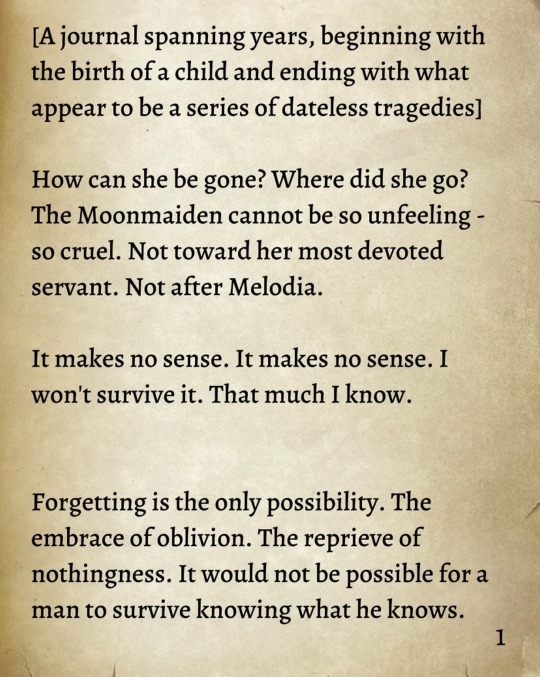

[A journal spanning years, beginning with the birth of a child and ending with what appears to be a series of dateless tragedies.] How can she be gone? Where did she go? The Moonmaiden cannot be so unfeeling - so cruel. Not toward her most devoted servant. Not after Melodia. It makes no sense. It makes no sense. I won't survive it. That much I know. Forgetting is the only possibility. The embrace of oblivion. The reprieve of nothingness. It would not be possible for a man to survive knowing what he knows. Knowing what can be lost. Shar understands that. Hers is the only mercy I can comprehend. My mind is full of holes - yet not enough. The emptiness. The time. The nothingness. And still I remember. Still I remember it all. There is no mercy in this beating heart. There is no mercy in life at all.
He builds the Gauntlet of Shar (or maybe renovates and Shar-ifies it, maybe it was already there) beneath the Thorm mausoleum, connecting it to the much more ancient Grymforge area. Grymforge becomes a kind of base or stronghold for the Justiciar army while the Gauntlet is designed to test their mettle and prepare them for the task that will make them official Dark Justiciars—killing Aylin, though it's not clear when Ketheric and Balthazar lure her into the Shadowfell.
I'll get back to that later.
We know that Grymforge was used as a Dark Justiciar stronghold and possible training ground because of all the Sharran stuff we find there. It's like super obvious. The feasthall room, the dormitories, the weapons that lay everywhere. There's basically a whole Sharran city in the Underdark beneath and near Reithwin, some of which we can see from various points in Grymforge. In fact, if you go through the poisoned room where Nere is, you can see the Gauntlet down below.
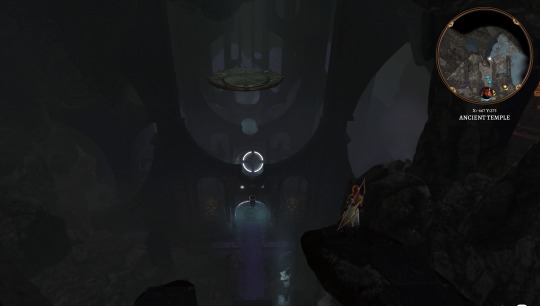

(It's a little hard to see here 'cause I play on console but there's a glimpse of the giant Shar statue that takes up a ton of space in the Gauntlet. Somehow, the two places used to connect.)
Ketheric's new Sharran teachings are ruthless and vicious. He encourages his Dark Justiciars to kill a Selûnite once a tenday or more as part of their training and service to the Lady of Loss.

The Law of Nightfall: From the moon falls the foulest of lights. iIt peeks through cracks and fissures, illuminating the most remote recesses of the Underdark. Light bestows hope, a pernicious notion which must be extinguished. At the darkest hour, pray to your Lady and feast in Her honour. The second day after, slay a disciple of Selûne. If none may be found, a Lathanderian or Mystran are an acceptable offering. Do this once a tenday, and the Lady of Loss shall know you.
Reithwin and the surrounding village soon become a hunting ground. Most people convert. Those who don't get hung in the square as examples (according to a shadow memory). All faithful Selûnites are forced to practice their devotion to the Moonmaiden in secret, led by Morfred the mason and his brother Halfred the innkeeper of Last Light Inn. Halfred hides Selûnite relics beneath Last Light (you can still find them) while Morfred plots a true resistance.

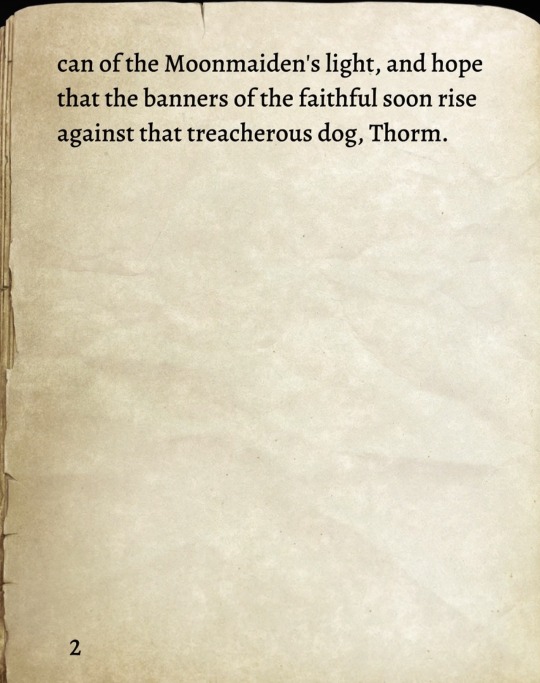
[Hidden amidst columns detailing the income and expenditure of a tavern is an aside, written in tiny, urgent handwriting.] I have concealed the sacred relics of our revered goddess in the darkest corner of this place. Morfred, my loyal brother, seeks to forge a network of allies to stand against the oppressive reign of Ketheric Thorm. Sadly, fear has gripped the hearts of many, turning them away from our cause. I cannot truly blame them, for trepidation fills my soul as well - but I must put aside my own fears and reunite with Morfred in the bowels of the Mason's Guild. Together, we shall preserve what we can of the Moonmaiden's light, and hope that the banners of the faithful soon rise against that treacherous dog, Thorm.
But as time goes on, Morfred grows increasingly distressed with the events happening in Reithwin and the ease with which people are eager to switch faiths.
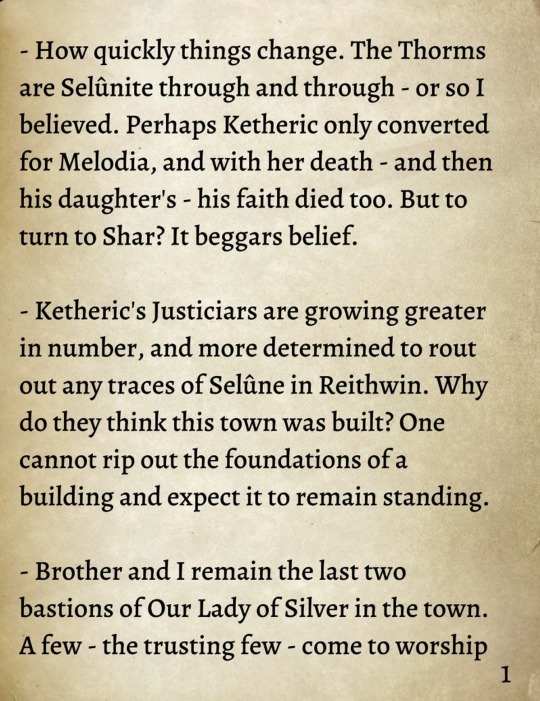
- How quickly things change. The Thorms are Selûnite through and through - or so I believed. Perhaps Ketheric only converted for Melodia, and with her death - and then his daughter's - his faith died too. But to turn to Shar? It beggars belief. - Ketheric's Justiciars are growing greater in number, and more determined to rout out any traces of Selûne in Reithwin. Why do they think this town was built? One cannot rip out the foundations of a building and expect it to remain standing. - Brother and I remain the last two bastions of Our Lady of Silver in the town. A few - the trusting few - come to worship in secret by moonlit nights. Others - converts, all. Whether they truly believe, I cannot say. Impossible, isn't it?
(Don't worry, the second page is further down lol spoilers!)
Life is not going well in Reithwin, even if you're not a Selûnite. Ketheric is determined to destroy all traces of Selûne and treason of any kind. His Dark Justiciars begin tormenting citizens to reveal pockets of Selûnite resistance. He also suffers no treasonous word against him, even if the citizens in question aren't Selûnite. We see a glimpse of this and of the Justiciars' cruel influence during the questline with He Who Was and Madeline, who ratted out her friends' innocent(?) complaints about Ketheric to some Justiciars, resulting in their brutal deaths.
Eventually Morfred realizes that the Dark Justiciars are too powerful to resist and turns to Raphael, offering his soul in exchange for something to destroy the Dark Justiciar army.
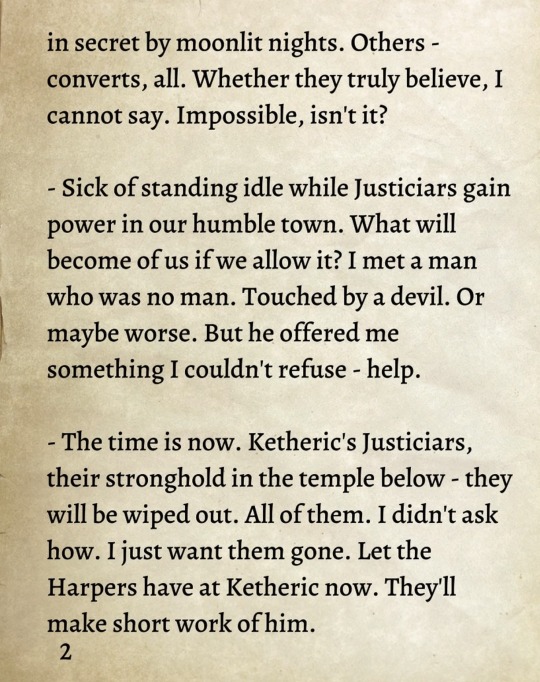
- Sick of standing idle while Justiciars gain power in our humble town. What will become of us if we allow it? I met a man who was no man. Touched by a devil. Or maybe worse. But he offered me something I couldn't refuse - help. - The time is now. Ketheric's Justiciars, their stronghold in the temple below - they will be wiped out. All of them. I didn't ask how. I just want them gone. Let the Harpers have at Ketheric now. They'll make short work of him.
You can ask Morfred about this in the House of Hope, actually, where he confirms the details. I mean, he's in Raphael's house, so it's pretty obvious the he did, in fact, make a deal with him.
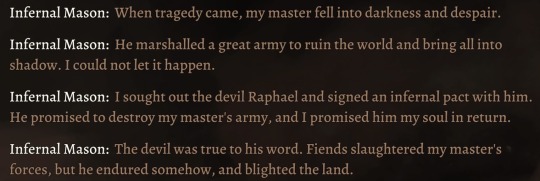
Infernal Mason: When tragedy came, my master fell into darkness and despair. He marshalled a great army to ruin the world and bring all into shadow. I could not let it happen. I sought out the devil Raphael and signed an infernal pact with him. He promised to destroy my master’s army, and I promised him my soul in return. The devil was true to his word. Fiends slaughtered my master’s forces, but he endured somehow, and blighted the land.
The Fiend in question here is Yurgir, who ends up crashing through Grymforge and the Gauntlet to kill all Dark Justiciars in his path. (He misses one, because Raphael is a sneaky bastard who let one get away by turning him into a swarm of rats, but I digress.) We know Yurgir caused the destruction in Grymforge, too, because of the Merregon masks and hellbeasts we find around the area, and the fact that if you pass all the checks with the Duergar mason examining the stone, he helps you piece together this narrative:

Stonemason Kith: An ancient city, hewn from the stone by the disciples of Shar, later abandoned. Untold centuries later, a new tribe revives it. Fresh walls, fresh sculptures...until a great hellbeast charges through, toppling the walls and crushing the people! Heh - that explains the infernal plate I found. Perhaps you might have use of it.
Further proof that Grymforge and the Gauntlet were once connected...somehow.
Anyway, by the time Yurgir is called in, Morfred's already been found out. Thisobald overhears him drunkenly complaining about Ketheric in the Waning Moon and informs Ketheric of his treachery. Ketheric orders a raid on the mason's guild, leaving Halfred the lone source of Selûnite resistance. It's unknown what becomes of Halfred, but considering the fact that the inn was still taking guests (like Art Cullagh) and housing the Harpers right before the shadow curse descended (there's a shadow memory of a Harper toasting his comrades in Last Light right before the battle with Ketheric long ago), it's likely he's a victim of the curse and not Justiciar brutality.
I’m not sure which is worse, honestly.
It's unclear when Morfred dies, though he admits to witnessing the first part of the shadow curse (i.e., "...but he endured somehow, and blighted the land"). But Morfred's deal coincides in some ways with the arrival of the Harpers and druids. I think he probably makes the deal with Raphael before the Harpers officially march against Ketheric and then gets caught after he hears rumors of the Harpers.
Raphael makes good on his deal around the same the Harpers arrive, perhaps a little afterward. This means Yurgir's slaughter of Justiciars in the Underdark must happen concurrently with the battle happening topside between Ketheric's army and the Harpers/druids, meaning Ketheric is losing his army on two fronts at the same time. Victory seems assured for the Harpers and druids, but of course we know now that Ketheric had a way of cheating death already in place.
He had already imprisoned the Nightsong in a Shadowfell soul cage.
Again, we’re not sure exactly when this happens, but it’s after Isobel dies and before the shadow curse, which unleashes with Ketheric’s supposed death in the battle against the Harpers and druids. However, Aylin herself says that Ketheric and Balthazar lured her into the Shadowfell under the pretense of saving an innocent.

Dame Aylin: He and his loathsome advisor Balthazar lured me into the Shadowfell, claimed they'd found someone in need of my aid. There they trapped me in their infernal cage. I was killed, murdered, made dead, over and over and over by Justiciars of every make and kind. I was reborn, for it is my nature. And Ketheric fed upon my immortality all the while.
This makes me think that Aylin wasn’t aware of Ketheric’s conversion yet, so it must have been very soon after, because otherwise, why would she trust a known Sharran telling her to enter the Shadowfell, the realm that is entirely under Shar’s control? I also suspect Ketheric built (or renovated) the Gauntlet around Aylin after her capture, perhaps at the behest of Shar due to their collaboration in making up new Justiciar teachings, or perhaps out of a sick, vengeful desire to see Aylin tormented for daring to love his daughter.
If this is true, then there’s a very real chance that Ketheric was unkillable before he truly started to torment Reithwin town, and well before the Harpers stepped in to take him down.
Anyway we at least know that Ketheric trapped Aylin in the Shadowfell before the big battle against the Harpers because a) both Isobel and Aylin talk about her being there for a century and b) because Ketheric is already using her invulnerability to survive assassination attempts on his life prior to or during the actual battle against him and his army:
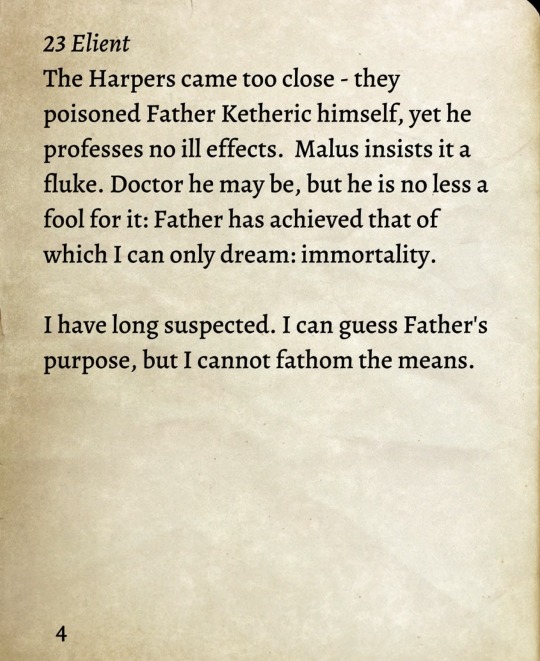
23 Elient The Harpers came too close - they poisoned Father Ketheric himself, yet he professes no ill effects. Malus insists it a fluke. Doctor he may be, but he is no less a fool for it: Father has achieved that of which I can only dream: immortality. I have long suspected. I can guess Father's purpose, but I cannot fathom the means.
This brings us to the eve of the battle itself. But this post is already hella long, so keep an eye out for part 2, all about the Harper and druid battle against Ketheric!
#bg3#bg3 lore#bg3 meta#bg3 discourse#halsin#halsin silverbough#ketheric thorm#jaheira#my thoughts#deep dive#baldur's gate 3#long post#super long post#bg3 critical#bg3 spoilers#bg3 screenshots#who needs sleep when i can just read 24125234 bits of lore#and red string theory my way into madness#also I haven’t mention Halsin and Jaheira much in this post#but they’re coming up soon I promise lol
125 notes
·
View notes
Text
Out of Sight - part 1
Summary: Moriarty is your boss. After he helped you out of a precarious situation when you were still a minor, you started working for him. Now, he has a new job for you. Get close to the Holmes brothers to keep an eye on them for him. Pairing: Sherlock Holmes/John Watson, Mycroft Holmes/Reader & Jim Moriarty/Reader Fandom: BBC Sherlock Word count: 1492
Masterlist

Jim Moriarty is a tricky man to work for, yet you do. After meeting you while you were a seventeen year old that had gotten involved with the wrong crowd, he had seen potential in you. So, after some training from his right hand man, Sebastian Moran, you became one of his best. He even gave you a nickname, Spike, after your personality. When you initially started working for him, you were quite spunky and talked back whenever you felt like it. Now that you’re older and have worked in his organisation for a couple of years, you’ve mellowed out a bit when it comes to business and listening to Jim. Now, you’re a ruthless assassin that will do whatever you’re told to by a certain Irishman in the blink of an eye. Currently, you’re on your way to his estate out of town. The sleek car that picked you up is quite lavish, something you’d somewhat grown used to as he tends to enjoy showing off. You watch the trees flash by you as the car speeds up while music plays through your earbuds. It had been a while since you last were at the estate, as you’d been out of the country for business the past couple of months. The car eventually comes to a halt and you quietly get out.
‘My dearest Spike,’ Jim smiles when you step into his office, ‘it has been a while hasn’t it?’ ‘It has, sir.’ You smile back at him. ‘Business in Hong Kong has been settled without too much issue.’ You glance at Sebastian entering the room. ‘The target has been eliminated and you are now in control of the biggest criminal network.’ Moriarty’s smile turns into a grin. ‘That is wonderful to hear, I didn’t expect any less from you.’ His face suddenly becomes serious again and he turns to Moran. ‘Sebastian, do you have the files I requested?’ The other man only nods before putting the files onto the desk. ‘Good, good.’ He starts looking through before his eyes turn to you once again. ‘Spikey dear, come here. I want you to look through these documents and photographs today, I have a new assignment for you.’ You approach the table and file which is filled to the brim. There’s mostly pictures of and reports about consulting detective Sherlock Holmes. Jim walks around the desk and stands next to you on your right, while Sebastian is already on your left. ‘I want you to get close to Sherlock Holmes and his Brother, Mycroft.’ He points out a picture of the two of them. ‘Keep and eye on them for me. Gather as much information as you possibly can, I do not care how, as long as you don’t reveal your identity.’ Turning to him, you finally look the shorter man in the eye. ‘Of course sir.’ Sebastian shoves another file into your hands before he starts talking. ‘We’ve arranged for a new identity so you’ll be able to fly under the radar. Name: Charlie Moore, age: 27, occupation: intelligence analyst at Scotland Yard. Any other information you may deem necessary can be found in this file. You’ll move into 221C Baker Street tomorrow morning. We’ve already arranged for you to be able to stay there.’ That night you spent looking through the files that were given to you. Sherlock and Mycroft both seem quite interesting in their own rights. Sherlock is a high functioning sociopath that seems to get a thrill out of showing off his intellect and skills to others. His skill is quite incredible, but nothing you hadn’t seen from Jim before. Besides, deduction is a skill a person is able to learn, quite easily in fact. You’d been taught by Sebastian when you first joined Moriarty’s organisation, though your skills have been sharpened over time, with some help from the Irishman himself when he thought you could do better. Now, you rival Sherlock’s speed and skill when it comes to deduction. Still, you understand why your boss is such a fan, that is what he calls it anyway. You think it’s more of an obsession. Contrary to his brother, Mycroft doesn’t seem to enjoy showing off as obviously as Sherlock does, yet he does enjoy flexing his power from time to time. The files you possess show how Sherlock’s newest acquaintance had been picked up by the man’s secretary multiple times and driven to an ominous location so he could talk to John. Supposedly, he offers money to those that get close to his brother, so you’d be keeping that in mind. It does become clear, however, that Mycroft didn’t just hold a minor position within the British government. Clearly he, like your boss, constantly keeps an eye on the consulting detective.
The following morning you arrive at Baker Street using a cab, so as to not have any suspicions arise. You have two suitcases, mostly holding clothes, books, and other essentials. Your larger weapons have already been delivered to and hidden in your new flat, so you don’t have to worry about those. After knocking on the door, you’re greeted by Mrs. Hudson, your new landlady. ‘Good morning dear, you must be the new tenant.’ She smiles brightly. ‘Yes, very nice to meet you Mrs Hudson.’ You smile back and stick out your hand for her to shake it. She does so before letting you in. Before she leaves you be in the flat, to which some basic furniture had already been delivered, courtesy of Jim, she warns you about your upstairs neighbours. ‘I do hope you’ve read the warning about the noise carefully dear. Sherlock can be quite a lot with his antics.’ Despite not being too worried about the noise, having had to deal with plenty of situations which were significantly worse than a single man could accomplish, you make sure to assure her you’ll be fine. ‘Yes, of course Mrs Hudson. Noise does not tend to bother me very much and I’ll be away for work during the day, so I suppose I should be fine.’ You smile at her again before closing your door and starting to unpack. It is Sunday morning, so you want to try and unpack most of your things before the start of the workweek, tomorrow is your first day at Scotland Yard after all. Before you start unpacking though, you put in your earbuds and put on Radiohead’s album In Rainbows.
The day went by without much issue, or noise from the upstairs neighbours. Probably because Sherlock was on a case, as your employer had let you know. During that time, you’d hidden the last of your weapons in places which aren't deductible and gotten your image in check. Your persona was quite a boring one to be fair, and while there’s always a hint of truth in them to make it believable, your own life has a lot more excitement and risk. Still, that is something you have to intentionally hide from the brothers and their acquaintances. Looking at your watch, you decide it’s time to go to the shops, as you’d be likely to arrive once Sherlock’s already back and you’d have a reason to introduce yourself. ‘Bye Mrs Hudson. I’ll be back in a few.’ You close the door behind you and head out. When you return with a bag of food, you’re met by two men standing at the door. You immediately recognise them as Sherlock Holmes and Dr John Watson. ‘Excuse me, could you please step aside so I can get to my flat?’ You deliberately make your voice softer and quieter than it usually is as to come across as somewhat shy. The doctor steps aside without much hesitation while the detective just turns around and starts trying to deduce you. ‘You must be the new tenant. Nice to meet you, I’m John Watson.’ The short man smiles at you. You shake his hand before introducing yourself and turning to the taller man, though he isn’t much taller than you. ‘Sherlock Holmes, consulting detective.’ He looks you over once again. ‘You’re in the police force but no officer, your nails are too clean for that. You’re dressed as if you have a new job despite it being a Sunday, you’ve only brought clothes you wear to work, which means you don’t go out much or meet people in your free time. You prefer listening to music and reading books to social interactions.’ You feign surprise but are glad, those were all the markers you’d set for him to read. He turns around and heads up the stairs to 221B. ‘I’ll see you at Scotland Yard tomorrow.’ John quickly turns to you and apologises for his friend’s behaviour before following him up the stairs. He’s certainly a character. Didn’t notice a thing though. -S
I told you so, and that’s why I wanted you to do this. -JM
I’ll keep you updated. -S
#fanfic#ao3 writer#fanfiction#bbc sherlock#sherlock holmes#reader insert#sherlock reader insert#jim moriarty#mycroft holmes x reader#jim moriarty x reader#sherlock fandom#johnlock#sherlock bbc#sherlock x john#sherlock fanfic#no proofreading we die like men
71 notes
·
View notes
Text
(PART 2)Incorrect Quotes: Samsie edition
part 1

---------- Sammy : Susie, you do remember when we agreed we were better off as friends, right? Susie, naked in Sammy 's bed: No, I absolutely do not. Sammy , already taking off their clothes: Fuck… Me neither. ---------- Sammy : Did it hurt when you fell- Susie: From heaven? Wow, I didn’t think you were such a flirt- Sammy : No, I meant when you fell down the stairs. Susie: … Sammy : You just laid there for 15 minutes. ---------- Prophet Sammy : Okay, but what if we went to dinner not as friends this time? Evil Alice: AS ENEMIES?! Prophet Sammy : ---------- Sammy : Come to dinner tonight. I can’t cook, but I’ll bring plenty of free wine. Susie: Marry me. ---------- Sammy : I think I just figured something out. I got to go. Susie: Aren't you forgetting something? Sammy : Uuh…hesitantly kisses Susie's forehead before running out. Susie: No, pay your bill! Damn, who raised you? ---------- Susie: Hey, Sammy , what do you think it would be like if we had kids? Sammy: What would it be like? Inconvenient, mostly. Susie: No, I mean, what would they be like, the kids? You ever think about it? Sammy: Can't really say I have. Susie: You know, for someone as eccentric as yourself, you can be boring as fuck sometimes. Sammy: Sorry, Susie. For what it's worth, I'm picturing them now. A boy and a girl. Two perfect little freaks of nature raised by people who've clearly got no business bringin' up anybody. ---------- Susie: Talk dirty to me, baby~ Sammy: The dishes. Susie: Wh- Sammy: They’ve been there for 4 days and it’s your turn to wash them. You still haven’t cleaned them and I have asked you to do so several times. ---------- Susie, throwing their head into Sammy 's lap: Tell me I'm pretty! Sammy, lovingly stroking their hair: You're pretty fucking annoying, that's what you are. ---------- Susie: Babe, you're so funny! Sammy: We have 1492 days until your tragic premature death. You will break my trust three times before that happens, but I forgive you. Susie: Awwww, that's sweet of you!
generator here
#sammy lawrence#bendy and the ink machine#batdr#bendy and the dark revival#susie campbell#samsie#sammy lawrence batim#batim sammy#batim#batdr sammy#susie campbell x sammy lawrence
17 notes
·
View notes
Text
Random saints by Sittow or Catherine of Aragon's parents?

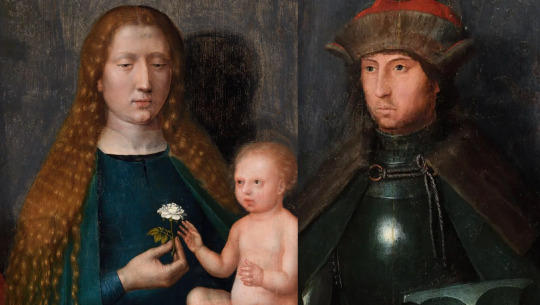
Read further if you wish to know what my theory is.
I first found this photo with mention it is by Sittow and at first I thought it is another portrait of Catherine. But quickly I realised this woman looks older and the features are not exactly the same.
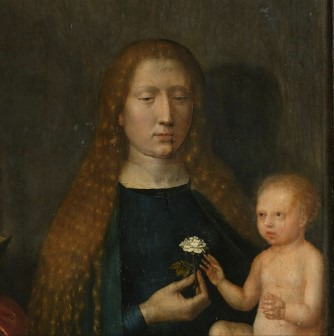
The nose is much narrower. And I started to wonder...we know that Sittow painted at least one portrait of Queen Isabella I of Castile.
And she had such nose. I could exclude possibility some of Catherine's sisters looked like this too, but women in that family tended to be very young-looking for really long.
So the age of sitter already is suggesting that it could be based upon Isabella towards end of her life. And it is also odd for depiction of Virgin Mary to depict woman who is not young...it is point in Isabella's favour.
While many claim Sittow painted Isabella in 1485, he was only born in 1468/1469 and didn't even become indipended master until at least 1488. He is first recorded working in Toledo in 1492. So he'd always be only able to depict Isabella over age of 40. And tbh, if this is her..then she looks great for somebody over 40!
But where is this image? It took me while to track down.
It's detail from wings of theThe Passion Altarpiece (Tallinn), its middle part is from c.1515-1520(with some 17th century additions) by different artist.

But I am not so sure how accurate is the dating of the outer wings by Sittow(1518-1525) which are in very different style, and might have originally belong to different altar middle.

If it is indeed 1518-1525 dating, then imo they are posthumous depictions based upon earlier sketches done from life. Sittow reusing those old sketches, using them as inspiration for his later work.
Link to photos only. Left pannel: https://artsandculture.google.com/asset/the-passion-altarpiece-outer-wing-with-the-virgin-mary-and-apostle-james-the-greater-paintings-of-the-outer-side-of-the-wings-by-michel-sittow-and-his-workshop/BwFnRG1v6gRqmQ
Right pannel: https://arthive.com/artists/75951~Michel_Sittow/works/526786~Saint_Adrian_and_Saint_Anthony
As to where they are located?
-Niguliste Museum(housed in former St. Nicholas' Church), which is part of Art Museum of Estonia(which combines collections from 3 other buildings+ this church). Hence in Tallin, Estonia but be aware there is over 3 km distance in between the church and other buildings.
But if anybody could go there and get us some pictures it'd be great (if it is allowed). Currently Niguliste Museum has exhibition about Sittow:

But back to the pannels. The left one depicts Madonna(Virgin Mary holding baby Jesus) and St. James the Great(apostle and patron saint of Spain:
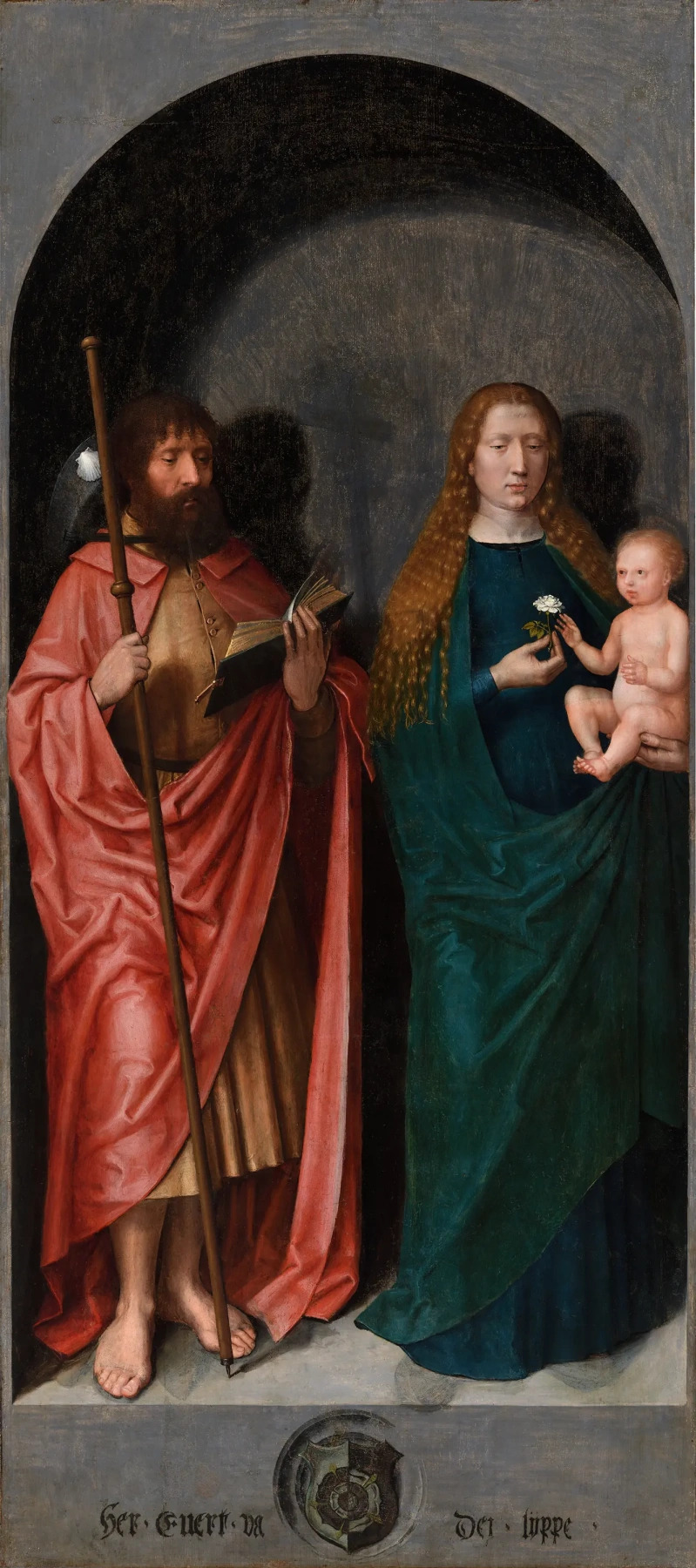
And please note that Tudor rose is combination of red and white rose and not always it was depicted as inner rose white, outer red. Sometimes they were halfed, with inner rose sometiems also switched.

Of course it could be some foreign coat of arms or later alteration.
Right pannel:

Here the coat of arms looks much newer and is probably altered(and if pomegranate turned out to be beneath it, I'd just die...)
The right pannel is depicting two male saints. On right is St Anthony the Great...was father of monasticism(of monastic life)...thus very important saint in christianity...
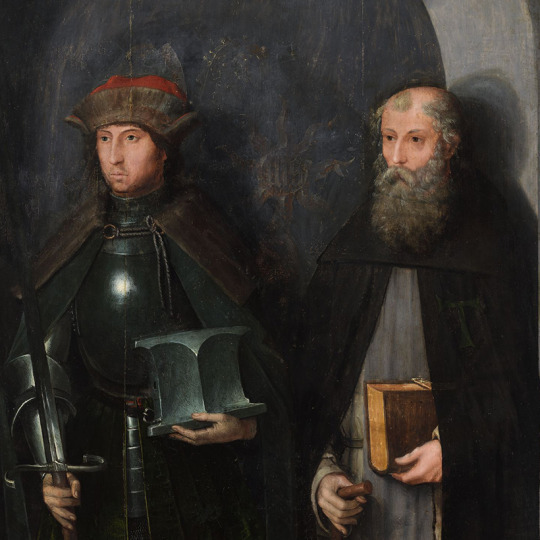
and on left St. Adrian of Nicomedia(2nd most popular military saint after St. George), and imo that's probably King Ferdinand II of Aragon:

It's not great likeness(brows not arched enough, looks bit slimmer, alla of nose not as defined), but overall it's enough of resemblence to not be able to exclude the possibility.
But if this is indeed done years after Sittow was in Spain...and he is reusing his old sketches of catholic monarchs to create this new religious scene(perhaps initially intended for them too, but never made into finished work before), then it is also possible that sketch done in pencil has partially rubbed off...and thus the differences in face of this male.
I think that if this was done while in Spain, such big differences are not very likely to occur. Not that pencil could not rub off, but I think Sittow would have noticed and cared about getting absolutely righ(to please his patrons) and thus would have corrected it.
Ehm, this kitty is supposed to be a lion:
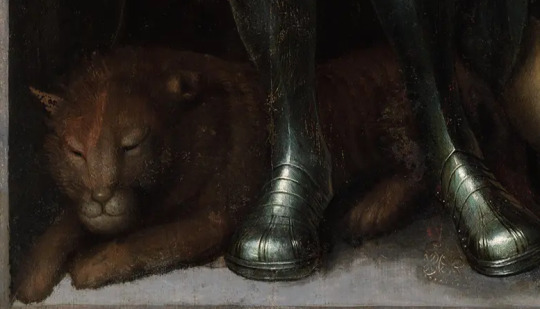
But you must be wondering, if Isabella indeed had this most vivid golden hair colour I always go on and on about, why does she have red hair here?
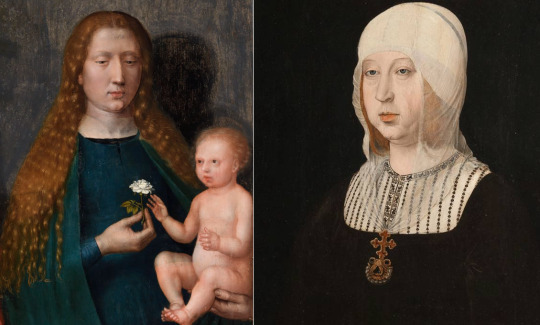
Several options to pick from: Pigments going wrong, Isabella's hair possibly turning to more reddish hues towards end of her life, or simply discoloured pinkish varnish which was very oddly applied...and on baby's skin you can see where somebody applied only one layer and where they went with brush for 2nd time.
If entire pannel has this varnish on, then it'd affect the hair, turning it more red. Why would such varnish not be removed? Sometimes money is tight and museums have multiple paintings to care for and those paintings in fairly good condition have to wait longer.
And sometimes it is not possible to remove discoloured varnish without harming the painting beneath.
Also worth of nothing is that Virgin Mary's dress is typically not teal, but vividly blue, the very best most expensive most vivid blue pigments were very often reserved for depicting the Virgin Mary:

Sometimes due to budget cost cheaper substitues were used, and those tend to fade.
Hence imo the colours originally might have been intended to be more like this(yes, I photoshopped it):

(I didn't change damn thing about male figure, just brightened it. But tbh I played with the woman's dress, skin and hair for while.)
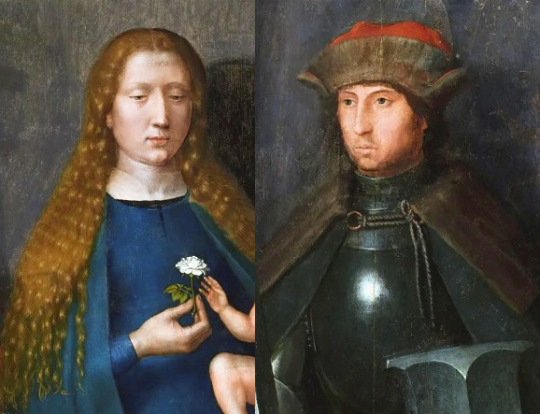
I mean if it looked like this now, fans of catholic monarchs would probably be all over it already.
But people overlook these dark slightly pinkish images located all the way in Estonia, even though it is atributed to Sittow himself!
(I don't mean people in Estonia, I mean people who search for Isabella's lost portrait by Sittow and stubbornly stuck to their favourite which is not even by Sittow!)

I honestly thought that people searching for lost portrait of Isabella by Sittow would have by now checked all his work, to see if perhaps she is there somewhere! Just doesn't look teen or young adult.
So I want you to be aware, if you're on quest of finding Isabella by Sittow's in that portrait with emerald necklace that this is imo the face you're looking for :
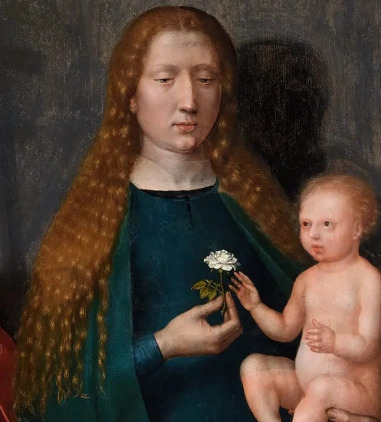
Possibly with hair bit more golden and skin more fair:
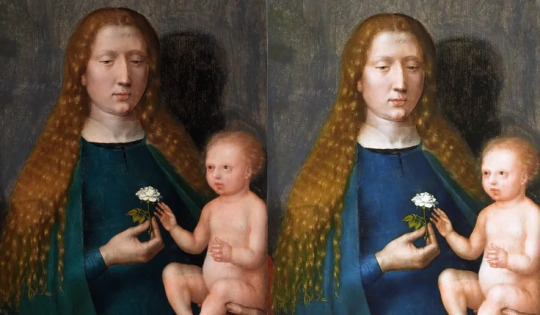
And it doesn't matter she doesn't look 20! She is still very beautiful.
Hence imo, these are Catherine of Aragon's parents, depicted in disguise of saints:

But I think they were likely painted years after Sittow left Spain, and his old sketches of them have been reused to create these pannels. I hope the experts will one day look more into this possibility.
I hope you've enjoyed this, and tell me what you think. Am I onto something or am I chasing shadows?


#historical portraits#isabella of castile#ferdinand of aragon#Isabella I of Castile#Ferdinand II of Aragon#sittow
78 notes
·
View notes
Text
The L Word: Faerûn, Part 3: The Chart, Pre-Canon
Previous part.
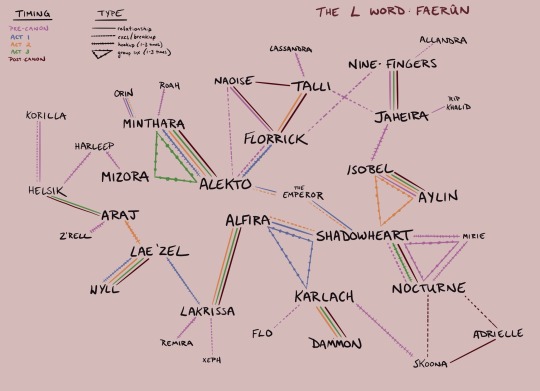
Having explained the overall premise and basically who "Alekto" is, it's time for the real meat of The L Word: Faerûn which is who's fucking who and when and why.
Thus, in more or less chronolgoical order, the pre-canon (pink lines) relationships/hookups/drama is as follows...
(over 100 years ago) Isobel and Aylin meet, piss off Isobels' dad, and lose each other, exactly as occurs in canon. Similarly, Jaheira lost Khalid as in canon.
(? years ago because these are just for seasoning and timing doesn't really matter) Helsik and her #1 rival/frenemy/LOHL Korilla have been on and off forever. They don't know they're desperately in love. Helsik has definitely also ~encountered~ Harleep and Mizora is too nosy and obnoxious to have never crossed paths with Harleep, and crossing paths with Harleep seems to mainly mean one (1) thing.
(c. ~30 years ago to ongoing) The long, rocky relationship between Alekto and Florrick was laid out already in the previous segment, since it explains much of the backstory for the entire TLW:F concept.
Alekto, Florrick, and Naoise Nallinto are also connected as part of a polycule. Alekto is more or less monogamous, but flexible enough for a well-definied poly relationship if desired by her partner. Florrick is definitively poly, and she and Naoise have been involved consistently for quite some time, including during Florrick and Alekto's relationship. Driven by their connection as city-dwelling wood elves, they find each other grounding and enjoy spending time together, but aren't compatible enough to be very serious. Florrick and Naoise remain involved with one another, even though Alekto split away some 10 years pre-canon. Alekto and Naoise had little in common, so they rarely spent time together without Florrick, but consider each other acquaintances up to the present day.
(c. ~30years ago to just before canon). Shadowheart and Nocturne were long-term sweethearts, each other's rock in the harrowing environment of the cloister, although if asked, either would downplay their feelings for each other in accordance with their lady's teachings. They never really broke up, but rather were on-and-off due to Shadowheart's sessions with the Mirror of Loss and having to often rebuild their not-a-relationship from scratch. Due to this, the eternal denial of their true feelings for each other, and the overall culture of sexuality in the cloister, they both often were involved with other members of the cloister (represented as Mirie on the chart but could be really anyone/multiple people) both individually and also there were definitely orgies.
(~20 years-5 years ago) Florrick and Nine-Fingers Keene also had a rivals-and-lovers situationship going, as a gung-ho younger Florrick hoped to make a name for herself in the Flaming Fist by taking down the rising star of the criminal guild, but things got sexy and dramatic fast. It has been several years since they last slept together, but the sexual tension endures. (For what it's worth, I think Nine-Fingers is in her mid-forties as of 1492.)
(~13 or so years ago). Teenage Hoodlums Karlach and Skoona were a casual, infrequent thing before Karlach went under Gortash's wing.
(~10 to 1ish years ago) After Gortash betrayed Karlach, she found some kind of fun, comfort, companionship (against her better judgement) in Flo the Garotter. Karlach would never admit they were ~together~ at all let alone for that long, but if you look at the facts, they don't lie.
Now look at Allandra Grey and tell me that woman is not running some kind of racket out of that temple!! Obviously Nine-Fingers would have a finger in that pie, and a finger in other things if you know what I mean. The city could NOT handle them together, it's like how the horses in Macbeth start eating each other to signify a rift in the natural order. Umberlee probably drowned a lot of people over it. Of course (not pictured) the Polycule From Hell that is Nine-Fingers' Ladies and the Umberlee cultists is alive and (not) well.
Now in the peri-canon realm (within the 1 year prior to), we got a lot going on in the Harper Corner:
Jaheira and Nine-Fingers have had a little casual thing going on for several years, nothing serious; Jaheira doesn't want a new one and only because she already had her one and only. They have some fun, they share information, they pick this thing back up in a couple months.
Now with the Harpers, Jaheira isn't out looking for anything, but you know when you're working so closely with people, and the stakes are so high, and the nights are so cold... shit just kinda starts happening. So Talli and Jaheira developed a bit of a thing while working together to mobilize the Harpers to go to the shadow-cursed land and take on Ketheric. Talli's a good gal, salt of the earth, humble, hard-working; she's ready to settle down but Jaheira is so far beyond settling down that it's just... not a good situation for either of them. Feelings hurt, Talli rebounds with Lassandra and that's really fine, but they just didn't have enough in common to build the kind of relationship either of them want, but they made for good bedfellows while it lasted.
Meanwhile, at one point Jaheira and Isobel get drunk, start reminiscing about their lost loves, and have sex. It WOULD be a secret they both take to their grave if literally everyone didn't know about it.
In the tiefling region, sorry but Lakrissa has bag-fumbler written all over her!! Of course she and Alfira flirt, but Lakrissa fails repeatedly to seal the deal and you know Alfira doesn't make the first move (hence why they have no pre-canon connection). (Also Alfira was desperately in love with Lihala in the most hopeless, idol worship crush way, but this was 100% one-sided so not on the chart). It also doesn't help that Lakrissa's ex-teenage-sweetheart from Elturel, Xeph, is also in their caravan. Xeph dumped Lakrissa because Lakrissa wouldn't get serious about her, a mistake Lakrissa claims she will never make again, but... bag-fumbler. Lakrissa also has some bouts of low self-esteem and since her post in the grove overlooks Aradin's crew camp, I imagine she got into a little something with Remira even though Remira, like Aradin, is a piece of shit (but she is also hot, so).
Lastly, we of course have the Minthara-Orin thing which is honestly not my cup of tea whatsoever, but exists and is thus on the chart. Just because I wanted her on the chart, I feel like Minthara and Roah Moonglow have banged at least once in the goblin camp since Minthra would need to blow off some steam with someone hot and also clean.
And of course Z'rell needed to be on the chart, so the question was, who could handle her? The answer was obviously Araj, whose unflinching craziness yet delusional serenity would be a fun and equal match to Z'rell's intensity. They smashed like 2-3 times in Moonrise.
Next: The Chart, Act 1
#as usual disclaimer that almost everyone on the Chart is bi/pan even if basically only F/F relationships are mentioned#the l word: faerun
23 notes
·
View notes
Note
did you go to uchicago? or was this a non-class time larp
I did not go to uchicago, no, but I did get a chance to play Ada Palmer’s 1492 Papal Election larp when she ran it for people outside the university last year. It was brilliant, easily in my top three larps of all time, and I’ve played (and written!) a LOT of larps. Definitely the most immersive game I’ve ever played, as costumes were provided and it ran in the extremely cathedral-esque Rockefeller chapel.



Pictured: a bunch of nerds sweating themselves to death in their robes the newly-elected Pope [REDACTED] IV addressing the college of cardinals and the monarchs of Europe, the procession of monarchs approaching to receive his blessing, and Holy Roman Emperor Maximilian I kneeling.
It was pretty intense.
36 notes
·
View notes
Text
baldurs gate dashboard simulator 1492 DR
🎲 3-4-5-2-9-7-17-3
monks are sooooo hot……..flurry of blow me 😭😭

🧌 phallusaluve
lol i got invited to an upper city party by a hauntingly beautiful pale woman with luminous blood red eyes. she said she was gonna give me a lift from the sewers. is anyone that fucking stupid . thats what i want to know
🏏 nightmayre-deactivated2948192
actually my cousin went to one of those parties and she said it was really incredible and the drugs they have there were very high quality. i would recommend not judging people just because they want to meet you in the sewers because sometimes in doing so you can close yourself off to a life changing experience. thats just my opinion though.
🧌 phallusaluve
LMAOOO VAMPIRE SPOTTED
# they think theyre so smart literally howww have they survived
🍞 lumpkinfigsworthstepsout
hey this is super rude actually like maybe she has a skin condition? sunlight sensitivity is a thing you know? like there are more and more drow leaving the underdark to escape lolth’s persecution. you don’t know anyone’s story. 🙄
🧌 phallusaluve
SHE HAD TWO HOLE SHAPED SCARS ON THE SIDE OF HER NECK???

🎓elfschool
all my haters become gators when i cast true polymorph

🌑 v0ides-wh1sper
[oil painting of the hem of a dark velvet dress artfully stained with mud, seemingly in a dark stone alley, with a romantic swishing motion as if the individual pictured is in the middle of running, a flash of an elegant curved silver dagger in their ring-covered hand]
# uppercity # femalejusticiar # L O S S C O R E

🪱 tadpoledadventurer
yeah yeah the squid that comes to you in your dreams and tells you about his mams butterknife. we’ve all tried to fuck him
☘️ lucksmercy
i
what the fuck
🪱 tadpoledadventurer
the squid?? you know him
🎻 daggerplusone
op your experiences are not universal

💐 summercrocus
DNI if you:
support the circus of the last days (aberration rights abuses)
have ever prayed to ilmater (glorifies suffering)
have fucked, or have ever considered fucking, the drow twins at sh*ress’ caress (do i even need to fucking say it)
have a postcode in the central lower city (neo-bourgeoisie)
are a sorcerer (self explanatory)
worship umberlee (self explanatory)
believe in bhaalspawn reformation (my mother was killed by a bhaalspawn)
🪙 insightcheck
fyi op is pro steel watch
# thanks for the free blocklist in the tags though

🌿 old-friends-senior-bear-sanctuary
i just want to get dicked down again
🧝♀️ featherfell
OLD-FRIENDS-SENIOR-BEAR-SANCTUARY?????

🐬 bitch-queen
Do u reckon the dark sisters would do top surgery. An absence in the chest area.
#Lady save our National Health Sharvice

⚖️ driderclitoris
NEED people to stop fucking in the graveyard. the mortarch has enough on her plate without you low lifes desecrating everywhere. youre not original and its crass. have some fucking respect
🏹 undrcty
sure thing, user driderclitoris. i’ll take that into account.
#bg3#long post#found this in the depths o my drafts i think i wrote it on an 8hr train journey You Can Tell
5 notes
·
View notes
Text

Shuukei Sesson, Monkey and Crab, 16th century, Muromachi period, Ink on paper, hanging scroll
Sesson Shukei (1492 - 1589) was a painter and monk of the late Muromachi and Sengoku periods who painted ink and wash pictures. He was also called Sesson Shuugi, and his real name and aliases include Nyokei and Tsurufune Roujin. He was a member of the Satake clan, but did not succeed to the samurai lineage. He admired the painting styles of Syubun and Sesshu, and later developed his own unique style. He was most skilled in landscape painting, but was also skilled in flower-and-bird and portrait painting.
雪村 周継 せっそん しゅうけい 1504年頃 – 1589年頃 《猿と蟹図》 16世紀・室町時代 紙に墨・掛軸
雪村(せっそん、明応元年(1492年)? - 天正17年(1589年)頃)は、室町時代後期・戦国時代の画僧で、水墨画を描いた。雪村周継とも称し、諱、別号として如圭、鶴船老人などがある。佐竹氏の一族であるが武家を継がず、禅僧となり、東国各地を遍歴し、後北条氏や蘆名氏など戦国大名の庇護を受けた。周文・雪舟の画風を慕い、のち独自の特色を発揮して一家を成す。最も山水画に長じ、花鳥画や人物画も能くした
11 notes
·
View notes
Text
08.11.23
#Mira-Marathon | Harry Potter
Film Name: Harry Potter and the Prisoner of Azkaban (2004); Production Studios: Warner Bros., Heyday Films, 1492 Pictures, P of A Productions Limited; Director by: Alfonso Cuarón; Screenwriter: Steve Kloves; Starring: Daniel Radcliffe, Rupert Grint, Emma Watson, Robbie Coltrane, Gary Oldman; Genres: Fantasy, Adventure, Family, Detective; Running Time: 2 hours 22 minutes;
"Harry Potter and the Prisoner of Azkaban" is the third film about Harry Potter, where Harry and his friends try to stop a dangerous prisoner, Sirius Black, who escaped from Azkaban. The film brings new characters and intense scenes, creating a darker atmosphere, and is a great continuation of the series, recommended to all fans of fantasy films.
My rating: 9/10

#mira marathon#harry potter#film#fantasy#adventure#harry potter and the prisoner of azkaban#2004#warner bros#heyday films#1492 pictures#p of a productions limited#alfonso cuarón#steve kloves#daniel radcliffe#rupert grint#emma watson#robbie coltrane#gary oldman#family#detective#2 hours#9/10
4 notes
·
View notes
Text
Un breve resumen: judíos y musulmanes en Marruecos
🇪🇸 El primer capítulo de "Judíos y musulmanes en Marruecos: sus mundos interrelacionados," editado por Joseph Chetrit, Jane S. Gerber y Drora Aarussy, explora la rica interacción cultural y política entre judíos y musulmanes en Marruecos. La conferencia "Uncommon Commonalities: Jews and Muslims in Morocco," organizada en junio de 2019 en Nueva York por el "American Sephardi Federation Institute of Jewish Experience," reunió a académicos de diversas partes del mundo para examinar esta interacción. La presencia judía en Marruecos se remonta al siglo VIII a.C., con la guerrera/priestisa Kahina resistiendo las conquistas musulmanas. Durante la Edad Media, la vida judía en Fez se vio enriquecida por correspondencias con estudiosos en Irak, conservadas en la Geniza de El Cairo. A pesar de enfrentar restricciones y el impuesto de jizya, los judíos marroquíes mantuvieron una vibrante vida cultural que incluía poesía, música y rituales compartidos con sus vecinos musulmanes. La colonización francesa en el siglo XX trajo cambios significativos, y aunque la comunidad judía marroquí ha disminuido de más de 250,000 en 1956 a aproximadamente 2,500 hoy en día, su influencia persiste en las comunidades judías en Israel, Francia, Canadá y Estados Unidos.
El capítulo también aborda la profunda influencia mutua en el ámbito lingüístico y cultural, destacando la interacción a través del "Darija" y el uso de múltiples lenguas en la vida cotidiana. Las mujeres judías adoptaron proverbios musulmanes y poesía oral beduina, mientras que el poeta israelí Najara (1555-1628) fusionó melodías árabes con poesía litúrgica hebrea. En el contexto político, la caída de Granada en 1492 y la posterior expulsión de los judíos de España llevaron a una migración significativa hacia Marruecos, aunque la recepción no siempre fue acogedora. Las fuentes históricas y crónicas reflejan un panorama complejo de desafíos y adaptaciones para los refugiados. A pesar de las dificultades, los judíos en Marruecos lograron establecer comunidades prósperas y transformar sus tradiciones culturales.
youtube
🇺🇸 The first chapter of "Jews and Muslims in Morocco: Their Intersecting Worlds," edited by Joseph Chetrit, Jane S. Gerber, and Drora Aarussy, explores the rich cultural and political interactions between Jews and Muslims in Morocco. The conference "Uncommon Commonalities: Jews and Muslims in Morocco," held in June 2019 in New York by the "American Sephardi Federation Institute of Jewish Experience," gathered scholars from around the world to examine these interactions. Jewish presence in Morocco dates back to the 8th century BCE, with the warrior-priestess Kahina resisting Muslim conquests. During the medieval period, Jewish life in Fez was enriched by correspondence with scholars in Iraq, preserved in the Cairo Geniza. Despite facing restrictions and the jizya tax, Moroccan Jews maintained a vibrant cultural life, including shared poetry, music, and rituals with their Muslim neighbors. French colonization in the 20th century brought significant changes, and although the Jewish community in Morocco has decreased from over 250,000 in 1956 to approximately 2,500 today, its influence remains in Jewish communities in Israel, France, Canada, and the United States.
The chapter also addresses the profound linguistic and cultural influence between Jews and Muslims, highlighting interactions through "Darija" and the use of multiple languages in daily life. Jewish women adopted Muslim proverbs and Bedouin oral poetry, while the poet Israel Najara (1555-1628) blended Arabic melodies with Hebrew liturgical poetry. In the political context, the fall of Granada in 1492 and the subsequent expulsion of Jews from Spain led to significant migration to Morocco, although the reception was not always welcoming. Historical sources and chronicles reflect a complex picture of challenges and adaptations for the refugees. Despite these difficulties, Jews in Morocco succeeded in establishing prosperous communities and transforming their cultural traditions.
#judaísmo#judaism#jewish#judío#cultura judía#jumblr#Marruecos#musulmanes#expulsión#1492#refugio#judíos sefardíes#sefardíes#sephardic jews#Fez#Meknes#filosofía#Jews and Muslims in Morocco: Their Intersecting Worlds#Jews and Muslims in Morocco#morocco#jews#muslims#intersecting worlds#partida de Iberia#iberia#refugio judío#Youtube
5 notes
·
View notes
Text

Savonarola's women
Sarah A Smith enjoys the painterly textures of Sarah Dunant's quattrocento Florentine tale, The Birth of Venus
The Birth of Venus by Sarah Dunant
Genre writing has provided fertile ground for feminist fiction. Detective stories, thrillers and historical novels have been pressed into service to explore gender-based issues of psychology, morality and injustice. Sarah Dunant, the author of eight widely praised thrillers, has switched allegiance with The Birth of Venus, a seductive and ambitious novel set in late 15th-century Florence.
Dunant's themes are archetypal: women and self-determination, women and creativity, women and marriage, women and God. Her spirited heroine, 14-year-old Alessandra, has a lineage that stretches back to the earliest novels by women: not pretty, but handsome; poor at dancing, but brilliant at Latin and Greek; she lives for art rather than romance, but is still susceptible to emotion. The antecedents of The Birth of Venus are clear, and sometimes quite recent - the picture Dunant draws of convent life as a "republic of women" at the book's close owes something to Michèle Roberts. The puzzle is, how has Dunant created a story that is so fresh, vibrant and utterly compelling?
Part of her success lies in the setting. The last 10 years of the quattrocento were politically tumultuous for Florence. The city's ruler, Lorenzo de Medici, died in 1492, leaving a void his weak son Piero could scarcely fill. The Dominican reformer Girolamo Savonarola held the populace in his sway for four terrifying years, preaching against moral corruption, material wealth and women (whom he banned first from church and then from the streets). All of this is eagerly dissected by Alessandra and her middle-aged husband Cristoforo, himself a political player and in mortal danger from "God's militia". And it is tempered with just enough detail (the prostitutes with their regulation bells, the lemon paste used to whiten Alessandra's inky hands) to prick one's imagination.
But when one thinks of Renaissance Florence, one thinks of art, and it is through her descriptions of frescoes and altar pieces, painted wedding chests and fine linens that Dunant hooks the reader. The colours, the textures, the feel of the brush in Alessandra's uncertain hand as she paints a figure in her family's newly commissioned chapel; all are so vividly realised it is hard not to share the heroine's intoxication. This book is a love letter to the glories of the city (the writer now divides her time between Florence and London), and an extremely persuasive one.
If the historical aspect of the novel is a departure for Dunant, she utilises the narrative skill she developed writing mysteries. Sometimes this can go awry: the subplot involving the murder of several sexual miscreants is not especially convincing, and the book's denouement is hurried and unlikely. But for the most part this author knows how to turn a plot, whether she is writing about the unravelling of complex family tensions or the nearly disastrous impact Savonarola has on an impressionable artist brought to the city from the Low Countries.
With its painterly background (Michelangelo has a shadowy role) and its heart-thumping emotional twists, this book could easily have been self-indulgent. Dunant's passionate knowledge of her subject, the fluidity of her prose and her commitment to storytelling instead make it an accomplished delight.
3 notes
·
View notes